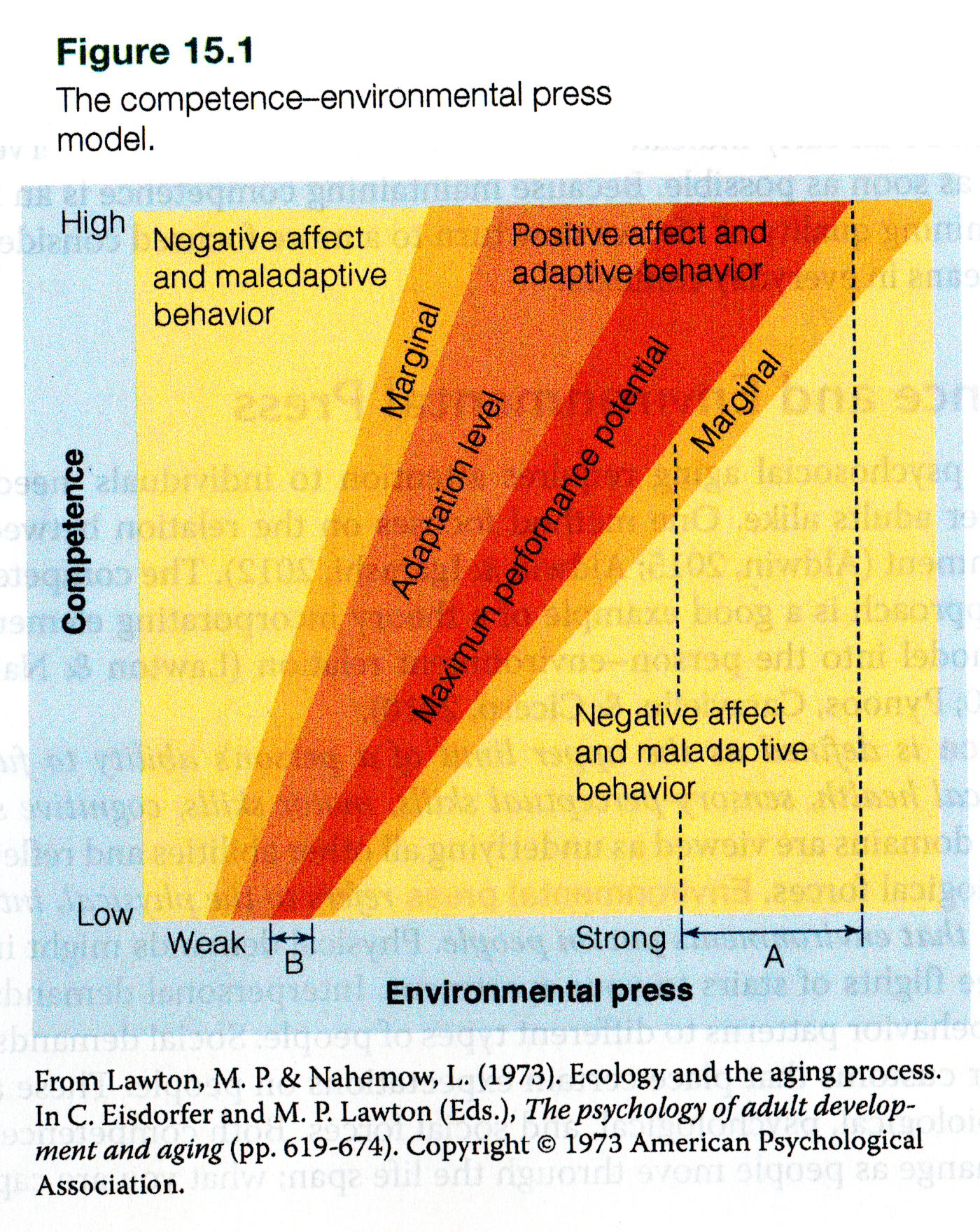SOCIAL ASPECTS OF AGING:
- General comparisons-- Other cultures value the elderly much more:
Traditional U.S. culture values "independence" ("cowboy" & frontier culture); devalues elderly
Most Asian (especially Chinese & Japanese) and Latin American cultures, also some
European cultures, value the elderly much more as sources of wisdom, tradition, etc.
- Healthy aging:
- Physical and emotional health: keeping healthy, keeping engaged, maintaining cognitive and physical functioning
- "Competence" vs "Environmental press" model:
"Environmental press" =
external (incl. social)
demands on people
"Competence" includes: - Physical health
- Sensory-Perceptual skills
- Motor skills
- Cognitive skills
- Ego strength
| 
|
Adaptation level-- Env. press is average for your level of competence (you can handle it)
Max. performance potential-- Env. press level is slightly higher (you need to try a bit harder)
- Proactivity: You control your own life: plan ahead, exercise, stay active & socially engaged
- vs Docility: You give up, let things happen (opposite of proactivity)
- Preventive adaptations-- to avoid stressors or build social resources:
Plan ahead; Exercise; Help others;
Health consumerism; More computer use
- Corrective adaptations (response to stressors): Get social support; Modify environment
- Healthier aging if more preventive adaptations (reduces need for corrective adaptations)
- Erikson: Integrity vs despair; life review (reminiscence and reflection)
- Emotional well-being (incl. Happiness) usually increases with advancing age
- Wincoff et al study (pg.510-511)-- Compare old (avg. age 69) and young (avg. age 23) adults:
- "Experience": Participants are shown an image, then rate how positive or negative the image was
- "Reappraise": Show image, but instruct subjects to distance themselves from the image emotionally,
then rate how positive or negative the image was.
- Result: More neutral in "Reappraisal", but older adults were less able to distance themselves from negative emotions.
- Functional MRI showed: Prefrontal cortex had increased activity during "Reappraisal";
Amygdala had decreased activity during "Reappraisal"
- Social and family relations become more important; helping out and feeling needed
- Spirituality and religion often increases among the elderly
Individuals with more religious and spiritual support were generally in better health,
more optimistic, better psychological well-being
Meditation and "mindfulness"-- effects are similar to traditional religion.
Functional MRI shows increased brain activity during meditation
- Caring for others (incl. pets) helps elderly people live longer!
--It's important to have a "sense of purpose"
Retirement and social adjustment:
- Most retirees still identify as "former" or "retired" practitioners of an occupation
- Why retire?
- Most often by choice if financially secure
- Sometimes involuntary (personal health, corporate downsizing)
- Some: pass a family business to the next generation
- Ethnic and gender differences-- poorly studied; most studies are of white men.
- Adjustments (benefits and losses):
- Health effects vary but are often negative: health may deteriorate, death rates increase
- Some retirees transition gradually to part-time work or reduced hours and responsibilities
- Many retirees substitute: 1) community involvement and volunteering, or
2) family involvement (more grandparenting)
- Many studies show: Sense of purpose leads to healthier aging and longer life-span.
Friends and family:
- Older women keep in touch with more friends than older men do.
- Larger family network ("social convoy") leads to better mental and physical health.
- Spouses, relatives, friends can all provide support; supporting others (incl. children, even pets) helps, too.
- Loneliness (lack of support) is a problem that can undermine health and well-being.
- Married elderly are healthier and live longer-- they take care of each other,
support each other emotionally, help each other with daily tasks and also reminders.
Elderly LGBTQ partners may be similar, but not well studied.
- Caring for a dependent partner can be very stressful for the caregiver.
Widowhood: experience loneliness, sense of loss; friends can make up for this somewhat.
Male widowers are fewer in number but often more lonely and coping is harder than for women
(older men have fewer close friends, on average, and are more reluctant to ask for help)
Great-grandparenthood-- increasingly common, but poorly studied
- Psychological ego support: seeing family continue; pride/comfort/meaning; easier to face death
- New diversion and meaning: transmit culture; more time and patience than most parents
- Milestone accomplishment: proud of contributing to another generation
Social issues:
- Frail elderly: physical limitations; need more & increasing care (expensive)
Activities of Daily Living (ADLs) become burdensome: feeding oneself, bathing, etc.
Family support (great emotional cost) vs Paid support (great financial cost)
Smoking, alcoholism, depression, & physical inactivity earlier in life all result
in increased frailty later.
- Various family arrangements, incl. living arrangements
- For any choice, "sense of place" ("my home") is very important
- Aging in place-- requires functional health in ADLs
- Assisgted living (don't need 24 hour care but need help with some ADLs)
- Nursing homes (24-hour care)
- Newer housing arrangements: Cohousing, Community housing.
- Social security, Medicare, and Elderly housing options: Current funding not sustainable as population ages--
problem of fewer wage-earners and more dependent elderly
|
